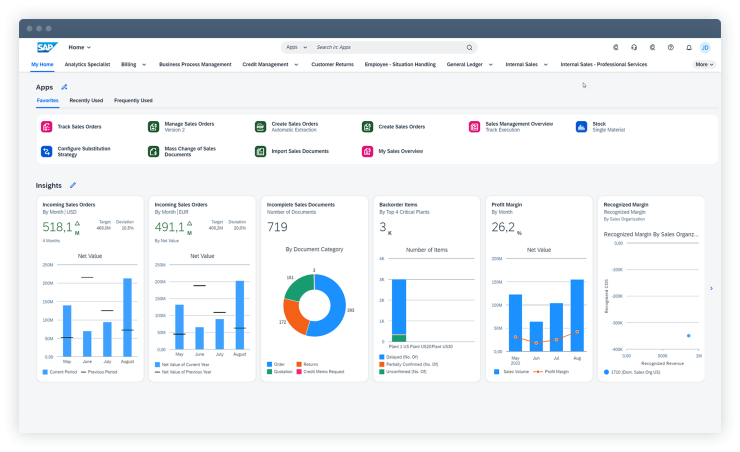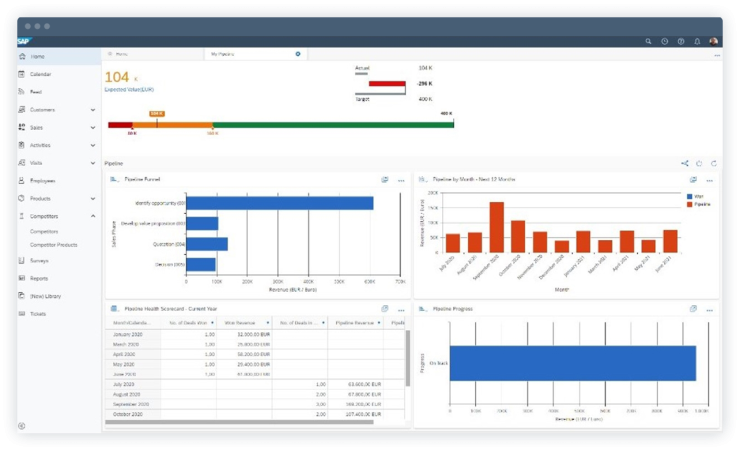
SAP S/4HANA unifies all critical business processes into a single platform. This system consolidates operations in areas such as finance, procurement, sales, manufacturing, asset management, and supply chain, leveraging SAP HANA's in-memory technology for real-time data processing and analysis.
Built on the powerful in-memory architecture of SAP HANA, the solution enhances responsiveness and enables real-time reporting and analytics, offering instant insights in dynamic business scenarios.
The platform supports both cloud and on-premise environments, making it suitable for small to large enterprises. The integration of specific modules for each functional area allows optimization of critical processes, improving interdepartmental communication and reducing data redundancy.
By incorporating artificial intelligence, machine learning, and predictive analytics, the solution anticipates trends and enhances operational efficiency. Its modular and scalable architecture provides flexibility for integrating new functionalities and connecting legacy systems, promoting technological advancement.
The intuitive and highly customizable interface offers a guided user experience through configurable dashboards and dynamic reports, streamlining training and reducing adaptation time across business areas.
The user experience, supported by SAP Fiori, stands out for its role-based and adaptive design. With customizable application catalogs and tiles, technical users can quickly access relevant transactions and reports. While this simplifies adoption, deep screen customization for highly specific needs may require additional development in SAPUI5, increasing early-stage project complexity.
One of SAP S/4HANA's strengths is its ability to run embedded analytics directly on transactions, eliminating the need to replicate data to separate warehouses. This is especially valuable for finance teams requiring fast period closings or sales teams needing up-to-the-minute dashboards. However, high-performance infrastructure (RAM-heavy servers and powerful CPUs) may require significant initial investment, particularly for mid-sized companies migrating from legacy systems.
From a computing and maintenance perspective, SAP S/4HANA implementation projects require technical experts in BTP (Business Technology Platform), SAP HANA data modeling, and functional module configuration. Despite having guides and preconfigured accelerators—known as SAP Best Practices—customizing highly specific business processes often requires enhancements or “Z” developments, which can complicate version control and updates. A “pure standardization” approach enables faster deployment but may not fully align with industry-differentiating processes.
Regarding scalability, SAP S/4HANA is designed to grow with the business. The HANA database allows data partitioning and distribution by nodes, supporting multinational environments or subsidiaries that require concurrent transactions and audits. However, migrating from SAP ECC or other ERPs demands a rigorous strategy: identifying obsolete custom code, reengineering processes, and reconciling master data are critical tasks that impact timeline and cost.
On the security front, the platform includes data encryption at rest and in transit, role-based access controls (RBAC), and detailed transaction auditing. Integration with external identity services (e.g., SAML-based Single Sign-On systems) simplifies user management in hybrid environments. However, configuring authorizations properly requires close coordination with internal governance teams, as SAP S/4HANA offers more granular permissions than many traditional ERPs.
Finally, the surrounding ecosystem shows that SAP S/4HANA benefits from a wide range of partners and specialized consultancies offering implementation, support, and industry-specific extensions. Regular updates (SAP Releases) introduce functional and performance improvements, but may require testing cycles and adjustments to custom developments. Organizations offloading large data volumes to external systems can rely on tools like SAP Data Services and SAP Analytics Cloud for advanced analytics, although they entail additional licensing and architectural considerations.
Main Features of SAP S/4HANA
-
Financial Management (FI): Tools for general ledger, accounts receivable and payable, asset management, and financial consolidation. Real-time data integration provides accurate financial insights.
-
Controlling (CO): Enables tracking and controlling internal costs, supporting detailed planning and analysis of operational expenses and profitability by cost centers or projects.
-
Materials Management (MM): Optimizes the supply chain through efficient purchasing, inventory, and supplier management, ensuring material availability and reducing storage costs.
-
Sales and Distribution (SD): Automates the sales cycle from order processing to invoicing and delivery, enhancing customer satisfaction and commercial efficiency.
-
Production Planning (PP): Coordinates production planning and execution, managing manufacturing orders, resources, and capacities to meet market demand.
-
Project System (PS): Supports planning, execution, and monitoring of complex projects, integrating resources, budgets, and schedules to ensure successful delivery.
-
Human Capital Management (HCM): Manages the full employee lifecycle including recruitment, development, compensation, and payroll, aligning human capital with business strategy.
-
Supply Chain Management (SCM): Provides visibility and control over logistics, inventory, and transportation, improving operational efficiency and responsiveness to demand changes.
-
Embedded Analytics: Includes data analysis and visualization tools that allow users to generate personalized reports and actionable insights directly from the ERP system.
-
Enterprise Asset Management (EAM): Monitors and maintains physical assets through preventive and corrective maintenance scheduling, maximizing availability and extending equipment lifespan.
-
Quality Management (QM): Ensures compliance with quality standards in production and supply processes through inspections, audits, and non-conformance handling.
-
Customer Service Management (CS): Manages post-sale services including service requests, work orders, and maintenance contracts, enhancing customer support and loyalty.
-
Master Data Management: Centralizes and maintains consistency of key data (customers, vendors, materials), ensuring data integrity and accuracy across modules.
-
Document Management System (DMS): Facilitates document storage, version control, and access related to business processes, enhancing collaboration and compliance.
-
Innovation and Product Lifecycle Management (PLM): Supports the entire product lifecycle from concept and design to production and retirement, integrating innovation into business strategy.
Strengths and Weaknesses of SAP S/4HANA
| Strengths | Weaknesses |
|---|---|
| Total integration of critical processes in a unified environment | Complex and prolonged implementation, potentially delaying deployment |
| Real-time processing based on in-memory technology | Steep learning curve for users without SAP experience; requires specialized training |
| Advanced analytics and predictive capabilities for decision-making optimization | High licensing and infrastructure costs |
| Modular, flexible, and scalable architecture adaptable to various industries | High technical requirements and reliance on specialized hardware |
| High security and regulatory compliance through robust controls | Implementing industry-specific processes may require deep customizations, conflicting with standardization |
| Role-based SAP Fiori interface enhances user experience and process adoption | Complexity in managing “Z” developments or custom extensions can hinder migrations and raise maintenance costs |
| Broad ecosystem of partners, integration tools, and SAP Best Practices to accelerate projects | Dependency on consultants and technical teams for customization, updates, and maintenance |
| Advanced security with data encryption, role-based access, and detailed audits ensures compliance | Infrastructure requirements (high-performance servers) may increase initial investment |
| Integration with third-party solutions via APIs and web services facilitates interoperability | Biannual updates, while beneficial, require testing cycles and adjustment of customizations |
Licensing and Deployment
SAP S/4HANA offers a hybrid model that allows both license-based pricing for on-premise installations and subscription/SaaS pricing for cloud solutions.
It is primarily designed for large enterprises, though there are adaptations for mid-sized organizations needing complex process integration. It can be deployed in traditional on-premise (server-based) environments and increasingly in the cloud, offering flexibility depending on infrastructure and organizational needs.
References
Official SAP S/4HANA page: SAP S/4HANA
- Printer-friendly version
- Log in to post comments


 SAP ERP is SAP's classic ERP solution for medium-sized and large companies, with specific modules for Plant Maintenance Management, Materials Management, Quality Management, Production Planning, Financial Management, Controlling, Asset Management, Project Management,…
SAP ERP is SAP's classic ERP solution for medium-sized and large companies, with specific modules for Plant Maintenance Management, Materials Management, Quality Management, Production Planning, Financial Management, Controlling, Asset Management, Project Management,…